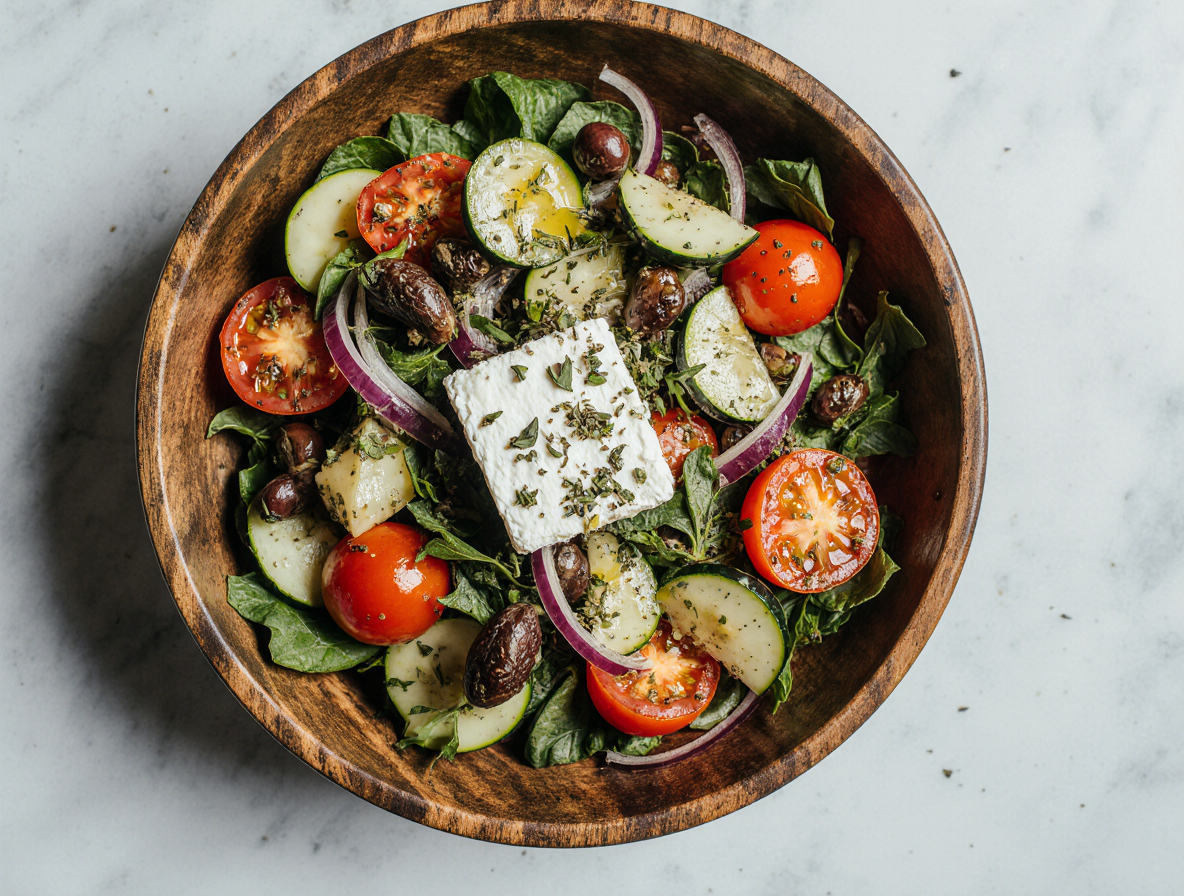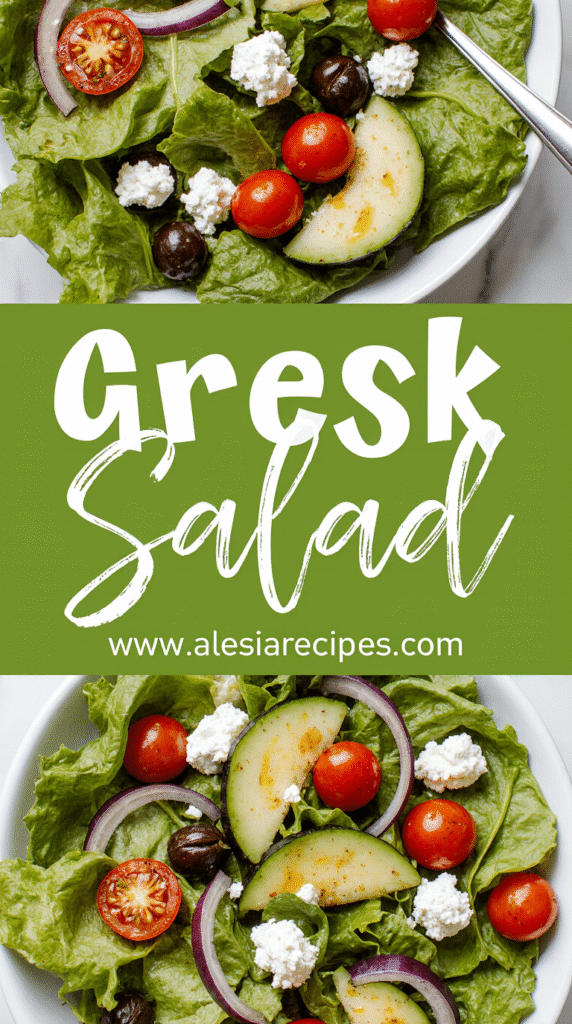How to Make an Authentic Greek Salad: A Traditional Recipe Guide
Did you know a greek salad recipe requires just 7 simple ingredients to create one of the most refreshing dishes of Mediterranean cuisine?
With only six ingredients — cucumbers, tomatoes, bell pepper, red onion, olives, and feta — this traditional greek salad (also known as “horiatiki” or “village salad”) lets the natural flavors of fresh vegetables shine without any lettuce fillers. In Greece, this authentic greek salad is served most often from early spring through summer and into mid-fall, making it a seasonal celebration of fresh produce.
Because the vegetables are in their prime, this classic dish is flavorful and refreshing with minimal preparation. We love how this easy recipe takes just 15 minutes to prepare, making it a perfect last-minute addition to any meal. Throughout this guide, I’ll show you exactly how to select the best greek salad ingredients and assemble them into a dazzling dish that captures all the best flavors of Greek cuisine, all in one easy summer salad! [-5]
Essential Ingredients for an Authentic Greek Salad
The foundation of an authentic greek salad relies entirely on the quality of its ingredients. Unlike many other salads, traditional greek salad doesn’t hide behind fancy dressings or numerous components—instead, each ingredient must stand confidently on its own.
Tomatoes, cucumbers, and bell peppers
For the perfect greek salad recipe, tomato selection is crucial. Roma or vine-ripe tomatoes work exceptionally well as they remain somewhat firm when ripe, creating ideal texture contrast with other vegetables. Alternatively, cherry or grape tomatoes can prevent excess water release into your salad.
When it comes to cucumbers, English varieties offer natural sweetness without the bitter skin found on regular cucumbers. If using standard slicing cucumbers, fully peel the waxy skin to avoid bitterness. Furthermore, seeding your cucumber prevents the salad from becoming watery.
Surprisingly, green bell pepper is the only authentic choice for a traditional greek salad. The firm, crunchy texture provides the perfect counterpoint to the softer tomatoes. Simply cut them into 1-inch squares or short strips for best results.
Choosing the right olives and feta cheese
Briny Kalamata olives are the cornerstone of any authentic greek salad. Their distinctive salty, briny flavor perfectly complements the fresh vegetables and feta. Many chefs prefer whole, pitted olives rather than sliced ones to preserve their juiciness.
For feta, quality makes all the difference. Genuine Greek sheep’s milk feta packed in brine offers superior flavor. Indeed, feta isn’t merely a topping but serves as the centerpiece of traditional greek salad recipes. Purchase feta in blocks rather than pre-crumbled varieties—this allows you to serve the large chunks characteristic of authentic preparations. The cheese should be firm yet crumbly, never dry or chalky.
Optional herbs and seasoning tips
While a traditional greek salad recipe remains simple with seasonings, dried oregano is non-negotiable. Apart from oregano, you might consider fresh herbs like dill or parsley for additional brightness.
A sprinkle of kosher salt enhances all flavors, while black pepper adds a gentle heat that balances the tanginess of the cheese and olives.
For those wanting to customize while maintaining authenticity, consider these additions:
- Fresh basil leaves for aromatic depth
- Capers for extra briny bursts
- Red bell peppers for color contrast and sweetness
Remember that the magic of an authentic greek salad lies in its simplicity—select seasonal, local produce whenever possible for the most vibrant flavors.
How to Make Traditional Greek Salad Dressing
Creating your own greek salad dressing elevates any traditional greek salad from good to exceptional. This simple vinaigrette requires minimal effort yet delivers maximum flavor when made with quality ingredients.
Classic ingredients: olive oil, vinegar, and herbs
The foundation of any authentic greek salad dressing lies in its simplicity. The primary components include:
- Extra virgin olive oil – Use the highest quality you can afford since the flavor shines through prominently
- Red wine vinegar – Select a bottle without sediment for cleaner flavor
- Fresh lemon juice – Adds brightness that bottled juice cannot match
- Dried oregano – The signature herb that gives the dressing its Greek character
- Garlic – Fresh minced provides robust flavor compared to powder
- Dijon mustard – Helps emulsify the dressing while adding depth
Combining these elements creates a tart, herby, garlicky, and balanced dressing that enhances vegetables without masking their natural flavors.
Tips for balancing acidity and flavor
The ideal ratio for a traditional vinaigrette follows the 1:3 formula—one part acidity (vinegar/lemon) to three parts olive oil. However, many chefs prefer equal parts oil and acid for a more pronounced tangy flavor.
For perfect balance:
- Whisk vinegar, lemon juice, mustard, garlic, and herbs together first
- Slowly drizzle in olive oil while whisking vigorously to emulsify
- Taste and adjust as needed
Should your dressing taste too pungent, add a pinch of sugar or honey to mellow the vinegar’s sharpness. Conversely, if too mild, increase the ratio of vinegar or add more fresh garlic.
Make-ahead and storage advice
Preparing your dressing ahead of time allows flavors to meld together and intensify. Once made, store in an airtight container or mason jar in the refrigerator.
The dressing remains fresh for approximately:
- 5 days when refrigerated
- Up to 2 weeks in some cases
As it sits, separation will occur—this is completely normal. Simply shake vigorously for about one minute before using. Additionally, olive oil may solidify in cold temperatures. If this happens, allow the dressing to sit at room temperature for 15 minutes or warm it briefly in the microwave (10 seconds) to return it to liquid form.
Step-by-Step Guide to Assembling the Salad
Assembling an authentic greek salad requires both proper technique and attention to detail. Let’s break down the process into manageable steps.
Prepping and cutting vegetables
Initially, I focus on cutting vegetables properly. For tomatoes, create 6-8 wedges or use halved cherry tomatoes to prevent excess moisture. Cucumbers should be sliced into ½-inch pieces, optionally creating a striped pattern with a channel knife for visual appeal. For bell peppers, cut into 1-inch squares or diamond shapes. Prior to mixing, consider soaking red onion slices in ice water with a teaspoon of vinegar for 10 minutes to reduce pungency.
Layering ingredients for best texture
Although traditional greek salad can be mixed together, layering creates stunning presentation. On a large platter or in a glass bowl, arrange vegetables strategically. Begin with cucumbers and tomatoes as the base, followed by bell peppers and onions. Place olives throughout, then top with large cubes of feta (not crumbles). This method ensures each serving contains all components.
When and how to add the dressing
Generally, dress the salad immediately before serving to maintain optimal texture. Pour half the dressing initially, toss gently, then add more as needed. To preserve freshness, store undressed salad and dressing separately in the refrigerator. As soon as you’re ready to serve, give the dressing a final whisk or shake, drizzle over the salad, and toss with minimal handling to avoid breaking the feta.
Serving, Storing, and Customizing Your Salad
A properly prepared authentic greek salad shines as both a standalone meal and versatile side dish. Whether served at home or brought to gatherings, knowing how to serve, store, and customize this Mediterranean classic elevates your culinary repertoire.
What to serve with Greek salad
Greek salad pairs perfectly with numerous dishes. For an authentic experience, serve alongside grilled pita bread that can soak up the delicious juices. Moreover, traditional Greek meals like spanakopita, pastitsio, or grilled chicken souvlaki complement the salad beautifully. For lighter options, pair with salmon topped with creamy dill sauce or grilled halloumi cheese. Essentially, this versatile salad works exceptionally well with:
- Mediterranean-inspired mains including lamb, chicken, or fresh fish
- Crusty bread varieties for dipping in the flavorful salad juices
- Hummus, tzatziki, or other traditional dips
- Simple pasta dishes with olive oil and herbs
How to store leftovers without losing freshness
Properly stored greek salad retains its quality for 3-5 days in the refrigerator. For optimal freshness, store the salad and dressing separately in airtight containers. This prevents vegetables from becoming soggy and extends shelf life up to 7 days. When meal prepping, wait to add tomatoes and feta until serving to maintain their texture.
Add-ins like chickpeas or grilled chicken
Transform your traditional greek salad recipe into a hearty meal by incorporating protein-rich additions. Chickpeas provide excellent plant-based protein while maintaining authenticity. Alternatively, grilled chicken, shrimp, salmon, or lamb creates a satisfying main course. For vegetarians, white beans or crispy tofu offer substantial alternatives. Other delicious customizations include:
- Diced bell peppers in various colors
- Fresh herbs like mint or parsley
- Avocado for creaminess
- Cooked quinoa or orzo for additional substance
Conclusion
Greek salad stands as one of the most beautiful expressions of Mediterranean cuisine through its remarkable simplicity. Throughout this guide, we’ve explored how just a handful of quality ingredients combine to create something truly special. The magic certainly lies in selecting the freshest tomatoes, crisp cucumbers, authentic feta, and briny Kalamata olives.
Remember, this traditional dish celebrates the natural flavors of each component rather than hiding them behind complex preparations. For this reason, your ingredient selection matters tremendously. Fresh, seasonal produce will always yield the most authentic results.
Additionally, the simple olive oil and red wine vinegar dressing enhances rather than overpowers these natural flavors. This balance represents the essence of Greek cooking – letting quality ingredients speak for themselves.
You can undoubtedly enjoy this versatile dish year-round, though it truly shines during spring and summer when vegetables reach peak ripeness. Whether served as a refreshing side or transformed into a complete meal with protein additions, Greek salad delivers nutrition and satisfaction in equal measure.
Above all, Greek salad reminds us that exceptional food doesn’t require complicated techniques or numerous ingredients. Sometimes, the most straightforward approach yields the most memorable results. Now that you know the secrets to authentic horiatiki, you can bring a taste of Greece to your table anytime – all in just 15 minutes!
FAQs
Q1. What are the essential ingredients for an authentic Greek salad? An authentic Greek salad, or “horiatiki,” consists of tomatoes, cucumbers, green bell peppers, red onions, Kalamata olives, and feta cheese. It’s dressed simply with extra virgin olive oil, red wine vinegar, and dried oregano.
Q2. How do you make a traditional Greek salad dressing? Traditional Greek salad dressing is a simple vinaigrette made with high-quality extra virgin olive oil, red wine vinegar, fresh lemon juice, dried oregano, minced garlic, and a touch of Dijon mustard. The typical ratio is 3 parts oil to 1 part vinegar, but this can be adjusted to taste.
Q3. Can Greek salad be prepared in advance? Yes, Greek salad can be prepared in advance, but it’s best to store the components separately. The vegetables can be cut and stored for 3-5 days, while the dressing can last up to 7 days in the refrigerator. Combine and add the feta just before serving to maintain freshness and texture.
Q4. How is Greek salad different from other Mediterranean salads? Greek salad is simpler and more focused than other Mediterranean salads. It doesn’t include leafy greens or grains, and specifically uses feta cheese. The emphasis is on fresh, chunky vegetables and a simple olive oil-based dressing, whereas other Mediterranean salads might incorporate a wider variety of ingredients and flavors.
Q5. What are some ways to customize a Greek salad? While maintaining its authenticity, you can customize a Greek salad by adding protein such as grilled chicken, shrimp, or chickpeas. For vegetarian options, you could include white beans or tofu. Other additions might be fresh herbs like mint or parsley, diced colorful bell peppers, or even avocado for creaminess.


